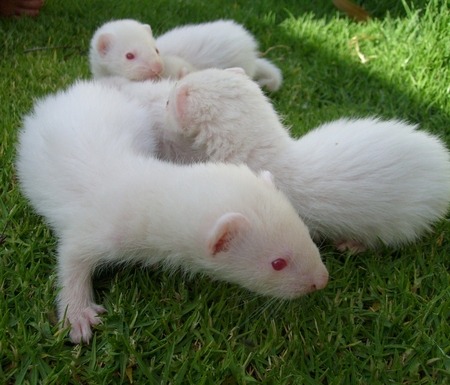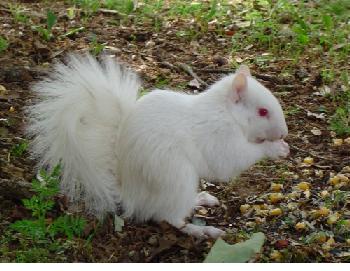|
|
|---|
Saturday, February 6, 2010
It snowed here all day yesterday, so I got to thinking about icebergs, for some reason. I say "for some reason" because of course we don't have any icebergs here in Missouri, since we lack an ocean. But icebergs are cold and white, just like snow, so maybe that's why I thought about them. Anyway, I asked Piper if I could write about icebergs in her blog, and she said, "Be my guest! But don't expect me to go walking around on any icebergs and getting my feet all frost-bitten!"
So I started doing some research on icebergs, and I found out that there is far more to be learned about them than I had ever imagined. In fact, there's probably more to say about them than will fit in one short blog entry, but I'll do my best to hit the high points, so to speak.
Icebergs are gigantic chunks of glaciers or ice shelves that have broken off and are now bobbing around in the ocean, causing hazards for ships. Icebergs are made out of fresh water, not salt water. And there is air trapped in the ice, which is why icebergs float. But as you probably know, about 80% or 90% of the iceberg is under the surface of the water, so this has led to the phrase "the tip of the iceberg," by which people mean that there is lots more to a situation than meets the eye. Here's a manipulated photo to show what an iceberg might look like if we could see the underwater part.
The tallest iceberg in the North Atlantic was 550 feet above sea level, which is as tall as a 55-story building. In general, though, icebergs range in height from 3 to 250 feet and weigh 100,000 to 200,000 tons. The North Atlantic ones can move about 10 miles a day.
Really big icebergs are all given names, and satellites keep track of their whereabouts so that ships won't run into them. Here's a list of recent large icebergs. You can enter any of these names in Google and find out all about the iceberg's history and present location.
Iceberg B-15 11,000 square kilometers, 2000
Iceberg B-15A 3,100 sq km (1,200 sq mi), broke off 2003
Iceberg C-19 5,500 sq km, 2002
Iceberg B-9 5,390 sq km, 1987
Iceberg D-16 120 sq mi, 2006
Iceberg B-17B 140 sq km (54 sq mi), 1999, shipping alert issued Dec. 2009
There are even different names for the different sizes of icebergs. The smallest ones are called Growlers, then you have the Bergy Bit (my personal favorite), followed by Small, Medium, Large, and Very Large.
Icebergs come in two basic shapes: tabular and non-tabular. The tabular ones are kind of like floating plateaus, with steep sides and a flat top. Here's a picture of one:
Non-tabular icebergs come in lots of different shapes, including dome, pinnacle, wedge, dry-dock, or blocky.
Of course, the most famous iceberg in history was probably the one that was struck by the Titanic on April 14, 1912. Here's a photo of the iceberg that people think must have been the one. It was found in the same area where some of the debris and bodies were picked up, and it had a red smear on it which may have come from red paint on the side of the ship. One thing that's amazing to think about is that the ice in this iceberg was probably more than 15,000 years old.
Because of global warming, Antarctica's ice shelves are shrinking and splitting, which means that icebergs are becoming even more common there. If you are worried about running into an iceberg in that region, you can go to this website to get the latest information from the National Oceanic and Atmospheric Administration: http://www.natice.noaa.gov/products/iceberg/
And finally, I will just share some photos I found of icebergs with stripes, because I think the stripes make them very artistic and cool-looking. This is not a trick that someone did with Photoshop! These stripes were formed by layers of snow that reacted in different ways to natural conditions. For instance, a blue stripe can result when a crevice in the ice sheet fills with melt water and freezes so quickly that there are no air bubbles in it.
A green stripe can happen when an iceberg falls into the sea, and seawater containing algae freezes to the bottom of it. Also, an ice sheet can pick up sediment as it is moving toward the sea, and this can produce black, brown, or yellow stripes in the ice.
Anyway, I guess that's all I'm going to tell you about icebergs. Right now I sort of feel like going and sitting in front of a heater.
So I started doing some research on icebergs, and I found out that there is far more to be learned about them than I had ever imagined. In fact, there's probably more to say about them than will fit in one short blog entry, but I'll do my best to hit the high points, so to speak.
Icebergs are gigantic chunks of glaciers or ice shelves that have broken off and are now bobbing around in the ocean, causing hazards for ships. Icebergs are made out of fresh water, not salt water. And there is air trapped in the ice, which is why icebergs float. But as you probably know, about 80% or 90% of the iceberg is under the surface of the water, so this has led to the phrase "the tip of the iceberg," by which people mean that there is lots more to a situation than meets the eye. Here's a manipulated photo to show what an iceberg might look like if we could see the underwater part.
The tallest iceberg in the North Atlantic was 550 feet above sea level, which is as tall as a 55-story building. In general, though, icebergs range in height from 3 to 250 feet and weigh 100,000 to 200,000 tons. The North Atlantic ones can move about 10 miles a day.
Really big icebergs are all given names, and satellites keep track of their whereabouts so that ships won't run into them. Here's a list of recent large icebergs. You can enter any of these names in Google and find out all about the iceberg's history and present location.
Iceberg B-15 11,000 square kilometers, 2000
Iceberg B-15A 3,100 sq km (1,200 sq mi), broke off 2003
Iceberg C-19 5,500 sq km, 2002
Iceberg B-9 5,390 sq km, 1987
Iceberg D-16 120 sq mi, 2006
Iceberg B-17B 140 sq km (54 sq mi), 1999, shipping alert issued Dec. 2009
There are even different names for the different sizes of icebergs. The smallest ones are called Growlers, then you have the Bergy Bit (my personal favorite), followed by Small, Medium, Large, and Very Large.
Icebergs come in two basic shapes: tabular and non-tabular. The tabular ones are kind of like floating plateaus, with steep sides and a flat top. Here's a picture of one:
Non-tabular icebergs come in lots of different shapes, including dome, pinnacle, wedge, dry-dock, or blocky.
Of course, the most famous iceberg in history was probably the one that was struck by the Titanic on April 14, 1912. Here's a photo of the iceberg that people think must have been the one. It was found in the same area where some of the debris and bodies were picked up, and it had a red smear on it which may have come from red paint on the side of the ship. One thing that's amazing to think about is that the ice in this iceberg was probably more than 15,000 years old.
Because of global warming, Antarctica's ice shelves are shrinking and splitting, which means that icebergs are becoming even more common there. If you are worried about running into an iceberg in that region, you can go to this website to get the latest information from the National Oceanic and Atmospheric Administration: http://www.natice.noaa.gov/products/iceberg/
And finally, I will just share some photos I found of icebergs with stripes, because I think the stripes make them very artistic and cool-looking. This is not a trick that someone did with Photoshop! These stripes were formed by layers of snow that reacted in different ways to natural conditions. For instance, a blue stripe can result when a crevice in the ice sheet fills with melt water and freezes so quickly that there are no air bubbles in it.
A green stripe can happen when an iceberg falls into the sea, and seawater containing algae freezes to the bottom of it. Also, an ice sheet can pick up sediment as it is moving toward the sea, and this can produce black, brown, or yellow stripes in the ice.
Anyway, I guess that's all I'm going to tell you about icebergs. Right now I sort of feel like going and sitting in front of a heater.
0 Comments:
Subscribe to:
Post Comments (Atom)






















